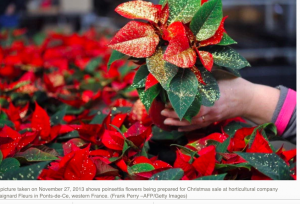
As with most things, if you’re in doubt about whether something may kill you if ingested, don’t eat it. If you’re not sure if something will die if planted outdoors, go ahead and plant it.
My most recent plant rant was about poinsettias, an often misunderstood and mispronounced plant that comes and goes around the holidays.
Those are two stories for you to briefly cherish, but remember the plant is native to Mexico and Guatemala. You’re welcome to try the plant in Chico soil, but don’t be bummed if your only success is a lesson learned.
I’m generally leery of plants purchased as a holiday table centerpiece. Growers take great care to provide perfect temperatures and lighting conditions, often difficult to replicate inside your home. If those plants survive they look like Lindsay Lohan before checking herself in for another round of rehab.
My research shows poinsettias will, indeed, grow in zones 9-11. (We’re in zone 8 or 9 depending on your zip code.) Yet, just because it will grow does not mean it’s the most beautiful choice for your fence line.
In their original growing grounds, poinsettias can reach 10 feet, but expect a less robust barricade in our zone 8 or 9. Or the plant could die in a cold snap.
The Garden Know How website states that the plant could die, roots and all, with sustained temperatures below 50 degrees. We’ve had mild winters the past few years, but very chilly winter nights occur more years than not.
Personally, if I’m going to have a green bush in my yard for the entire year, I want to look forward to one season with bright blooms. Pyracantha gives us red berries. Flowering quince blazes with flowers in very early spring. Fragrant rosemary blooms with subtle purple gifts to bees, and so on … Poinsettia? You’ll have a green bush.
Is it poison?
And then comes the question of whether poinsettias are poisonous. Yes. They’re not good to eat. This means don’t add decorative red bracts to your winter salads. However, on the toxicity list, poinsettia is fairly mild.
The University of Vermont Department of Plant and Soil Sciences reports authoritatively that no deaths from eating poinsettia have been recorded. The sap can cause blisters if not washed off right away. The leaves are toxic, if you consumed a lot of them. So please stop your pets and children from eating an entire plant.
While I was perusing the lists of seriously toxic plants, I came across many pictures and words about plants that could be used to concoct a deadly potion.
We’ve heard tales of nightshade, which has startlingly beautiful flowers. Roman fighters dipped their arrows in nightshade juice, and other legends tell of armies falling after passing bottles of nightshade-enhanced sweet wine.
Other plants that are toxic may be more surprising.
One poison control web list reminds us that apple seeds contain toxicants and the pits of cherries, peaches, plums and nectarines are all on the do-not-each list. Other non-nibblers include azalea, rhododendron, Caladium, elephant ear, foxglove, holly, iris, lantana, lily-of-the-valley, mistletoe, morning glory, mountain laurel, pennyroyal, philodendron (a very common houseplant) and water hemlock. Hydrangea is also toxic, but you’d need to eat a lot of pretty leaves.
From that list I could get seriously sick in my own back yard.
The bottom line, of course, is to do some research before you add something new to your salad.
Daffodils are also on the do-not-eat list, which makes sense since even squirrels and deer have learned to leave them alone.















